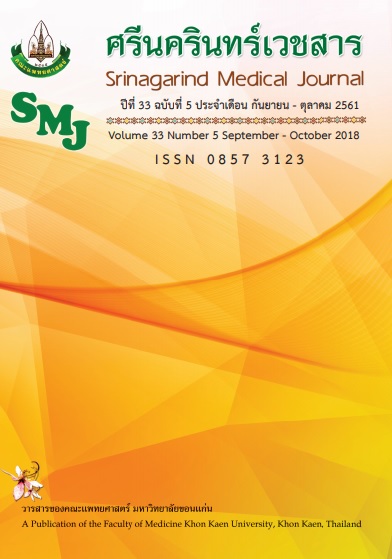The Prevalence of Unplanned Pregnancy at Antenatal Care Clinic
Keywords:
Unplanned PregnancyAbstract
ความชุกของการตั้งครรภ์โดยไม่ได้วางแผนในสตรีที่มาฝากครรภ์
ภาณิชา วัฒนากมลชัย1, อารีย์พรรณ โสภณสฤษฎ์สุข2, ยุทธพงศ์ วีระวัฒนตระกูล1, เจศฎา ถิ่นคำรพ1
1ภาควิชาสูติศาสตร์และนรีเวชวิทยา คณะแพทยศาสตร์ มหาวิทยาลัยขอนแก่น ขอนแก่น ประเทศไทย
2ภาควิชาสูติศาสตร์-นรีเวชวิทยา โรงพยาบาลรามาธิบดี คณะแพทยศาสตร์ กรุงเทพ ประเทศไทย
หลักการและวัตถุประสงค์: การตั้งครรภ์ที่ไม่ได้วางแผนมักจะให้ผลการรักษาที่ไม่ดีอย่างที่ต้องการ ดังนั้นจุดประสงค์ของการศึกษาครั้งนี้เพื่อค้นหาความชุกของการตั้งครรภ์โดยไม่ได้วางแผน และปัจจัยเสี่ยงที่เกี่ยวข้อง
วิธีการศึกษา: ทำการศึกษาแบบตัดขวางตั้งแต่วันที่ 1 สิงหาคม 2556 จนถึงวันที่ 30 เมษายน 2557 ผู้เข้าร่วมโครงการคือหญิงตั้งครรภ์ที่มาฝากครรภ์ จำนวน 240 ราย โดยจะได้รับการสัมภาษณ์ด้วยแบบสอบถามเกี่ยวกับ 1) ข้อมูลพื้นฐาน เช่น อายุ ระดับการศึกษา สถานภาพสมรส รายได้ อาชีพและอื่น ๆ 2) ข้อมูลด้านสุขภาพทั่วไปรวมทั้ง 3) ข้อมูลทางนรีเวช
ผลการศึกษา: พบความชุกของการตั้งครรภ์โดยไม่ได้วางแผนร้อยละ 30 โดยมีค่าเฉลี่ยและค่ากลางแปรปรวนของอายุหญิงตั้งครรภ์ 28.34 ปีและ 5.39 ปี ตามลำดับ การวิเคราะห์ตัวแปรเดียวพบว่ารายได้ที่น้อย (≤10,000 บาทต่อเดือน) สถานภาพโสดและประวัติการมีบุตรของผู้ป่วยมีความสัมพันธ์กับการตั้งครรภ์โดยไม่ได้วางแผน ปัจจัยเสี่ยงที่สำคัญที่สุดที่คำนวณได้จากการถดถอยโลจิสติกหลายตัวแปร ได้แก่ รายได้และประวัติการมีบุตร หญิงตั้งครรภ์โดยไม่ได้วางแผน ใช้ยาคุมกำเนิดฉุกเฉินก่อนการตั้งครรภ์บ่อยกว่าหญิงตั้งครรภ์โดยวางแผน
สรุป: ความชุกของการตั้งครรภ์โดยไม่ได้วางแผนในหญิงตั้งครรภ์ที่คลินิกฝากครรภ์อยู่ที่ร้อยละ 30 กลุ่มผู้มีรายได้ที่เท่ากับหรือน้อยกว่า 10,000 บาทต่อเดือน และประวัติการมีบุตรเป็นปัจจัยเสี่ยงที่เกี่ยวข้องกับการตั้งครรภ์โดยไม่ได้วางแผน การเข้าถึงการคุมกำเนิดได้อย่างมีประสิทธิภาพและควรให้ความรู้แก่สตรีที่มีความเสี่ยงเพื่อหลีกเลี่ยงผลลัพธ์ที่ไม่พึงประสงค์จากการตั้งครรภ์โดยไม่ตั้งใจและผลเสียที่ตามมา
Background and Objectives: Unplanned pregnancies are associated with outrageous outcomes. The aims of the present study were to explore the prevalence of unplanned pregnancies and associated factors.
Methods: We performed a cross-sectional study from 1 August 2013 to 30 April 2014. The participants were pregnant women who attended antenatal care clinic. Two hundred forty pregnant women were interviewed with a questionnaire asking about 1) basic information such as age, level of education, marital status, career income, and so on 2) general health information and 3) gynecological data
Results: Prevalence of unplanned pregnancy was 30%. The mean and SD of the age of pregnant women was 28.34 and 5.39 years. The univariate analysis revealed that low income (≤10,000 baht/month), single marital status, and childbearing status of patients correlated significantly with the unplanned pregnancy. The most significant risk factors calculated from multivariate logistic regression were low income and childbearing status. Women with unplanned pregnancy used emergency contraceptive pills before pregnancy more often than those with planned pregnancy
Conclusion: Prevalence of unplanned pregnancy in pregnant women was 30 %. Low income and nulliparity were the risk factors associated with unplanned pregnancy. Effective and easy access to contraception, and knowledge education should be offered to women at risk in order to avoid poor outcome from unplanned pregnancy and its consequence.
References
References
Singh S, Sedgh G, Hussain R. Unintended pregnancy: worldwide levels, trends, and outcomes. Stud Fam Plann 2010; 41: 241-50.
Sriprasert I, Chaovisitsaree S, Sribanditmongkhol N, Sunthornlimsiri N, Kietpeerakool C. Unintended pregnancy and associated risk factors among young pregnant women. Int J Gynaecol Obstet 2015; 128: 228-31.
Naravage W, Vichit-Vadakan N, Sakulbumrungsil RC, Van der Putten M. Factors affecting decision making of low-income young women with unplanned pregnancies in Bangkok, Thailand. Southeast Asian J Trop Med Public Health 2005; 36: 775-82.
Sedgh G, Henshaw S, Singh S, Ahman E, Shah IH. Induced abortion: estimated rates and trends worldwide. Lancet 2007; 370: 1338-45.
Su JH. Unintended Birth and Children's Long-term Mental Health. J Health Soc Behav 2017; 58: 357-70.
Singh A, Upadhyay AK, Singh A, Kumar K. The Association Between Unintended Births and Poor Child Development in India: Evidence from a Longitudinal Study. Stud Fam Plann 2017; 48: 55-71.
Brittain K, Myer L, Koen N, Koopowitz S, Donald KA, Barnett W, et al. Risk Factors for Antenatal Depression and Associations with Infant Birth Outcomes: Results From a South African Birth Cohort Study. Paediatr Perinat Epidemiol 2015;29: 505-14.
Lindberg L, Maddow-Zimet I, Kost K, Lincoln A. Pregnancy intentions and maternal and child health: an analysis of longitudinal data in Oklahoma. Matern Child Health J 2015; 19: 1087-96.
Loeber OE, Muntinga ME. Contraceptive counselling for women with multiple unintended pregnancies: the abortion client's perspective. Eur J Contracept Reprod Health Care 2017; 22: 94-101.
Coombe J, Harris ML, Wigginton B, Lucke J, Loxton D. Contraceptive use at the time of unintended pregnancy: Findings from the Contraceptive Use, Pregnancy Intention and Decisions study. Aust Fam Physician 2016; 45: 842-8.
Hall JA, Barrett G, Phiri T, Copas A, Malata A, Stephenson J. Prevalence and Determinants of Unintended Pregnancy in Mchinji District, Malawi; Using a Conceptual Hierarchy to Inform Analysis. PLoS One 2016; 11: e0165621.
12. Borrero S, Callegari LS, Zhao X, Mor MK, Sileanu FE, Switzer G, et al. Unintended Pregnancy and Contraceptive Use Among Women Veterans: The ECUUN Study. J Gen Intern Med 2017;32: 900-8.
Brunner Huber LR, Smith K, Sha W, Zhao L, Vick T. Factors associated with pregnancy intention among women who have experienced a short birth interval: findings from the 2009 to 2011 Mississippi and 2009 Tennessee Pregnancy Risk Assessment Monitoring System. Ann Epidemiol 2018; 28: 372-6.
du Toit E, Jordaan E, Niehaus D, Koen L, Leppanen J. Risk factors for unplanned pregnancy in women with mental illness living in a developing country. Arch Womens Ment Health 2018; 21: 323-31.
Unintended Pregnancy in the United States New York: Guttmacher Institute; 2016. [Cited September 20, 2016] Available from: https://www.guttmacher.org/sites/default/files/factsheet/fb-unintended-pregnancy-us_0.pdf.
Singh S, Shekhar C, Acharya R, Moore AM, Stillman M, Pradhan MR, et al. The incidence of abortion and unintended pregnancy in India, 2015. Lancet Glob Health 2018; 6: e111-e20.
Rottenstreich M, Loitner L, Dar S, Kedem R, Smorgick N, Vaknin Z. Unintended pregnancies among women serving in the Israeli military. Contraception 2017; 96: 62-5.
Wise A, Geronimus AT, Smock PJ. The Best of Intentions: A Structural Analysis of the Association between Socioeconomic Disadvantage and Unintended Pregnancy in a Sample of Mothers from the National Longitudinal Survey of Youth (1979). Womens Health Issues 2017; 27: 5-13.
Chanda MM, Ortblad KF, Mwale M, Chongo S, Kanchele C, Kamungoma N, et al. Contraceptive use and unplanned pregnancy among female sex workers in Zambia. Contraception 2017; 96: 196-202.
Morse JE, Ramesh S, Jackson A. Reassessing Unintended Pregnancy: Toward a Patient-centered Approach to Family Planning. Obstet Gynecol Clin North Am 2017; 44: 27-40.
21. Goenee MS, Donker GA, Picavet C, Wijsen C. Decision-making concerning unwanted pregnancy in general practice. Fam Pract 2014; 31: 564-70.
Hall KS, Dalton VK, Zochowski M, Johnson TRB, Harris LH. Stressful Life Events Around the Time of Unplanned Pregnancy and Women's Health: Exploratory Findings from a National Sample. Matern Child Health J 2017; 21: 1336-48.
Borges ALV, Dos Santos OA, Fujimori E. Concordance between intention to use and current use of contraceptives among six-month postpartum women in Brazil: The role of unplanned pregnancy. Midwifery 2018; 56: 94-101.
Hohmann-Marriott BE. Unplanned pregnancies in New Zealand. Aust N Z J Obstet Gynaecol 2018; 58: 247-50.


